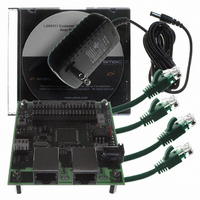EVB9311 SMSC, EVB9311 Datasheet - Page 127

EVB9311
Manufacturer Part Number
EVB9311
Description
EVALUATION BOARD LAN9311-NU
Manufacturer
SMSC
Series
0133r
Datasheet
1.LAN9311-NU.pdf
(460 pages)
Specifications of EVB9311
Main Purpose
Interface, Ethernet
Embedded
No
Utilized Ic / Part
LAN9311
Primary Attributes
2 Ports, 100BASE-TX/10BASE-T, Managed
Secondary Attributes
2 PHYs with HP Auto-MDIX, Auto- Flow Control, 32-bit CRC, MDI/MDI-X
Lead Free Status / RoHS Status
Lead free / RoHS Compliant
Other names
638-1076
- Current page: 127 of 460
- Download datasheet (5Mb)
Two Port 10/100 Managed Ethernet Switch with 16-Bit Non-PCI CPU Interface
Datasheet
SMSC LAN9311/LAN9311i
9.8.2.2
9.8.3
9.8.3.1
31:16
15:14
BITS
10:0
13
12
11
Data Start Offset [1:0]:
First TX Data Byte:
TX Command ‘B’
TX Data Format
The TX data section begins at the third DWORD in the TX buffer (after TX command ‘A’ and TX
command ‘B’). The location of the first byte of valid buffer data to be transmitted is specified in the
“Data Start Offset” field of the TX command ‘A’ word.
correlation between the setting of the LSB’s in the “Data Start Offset” field and the byte location of the
first valid data byte. Additionally, transmit buffer data can be offset by up to 7 additional DWORDS as
indicated by the upper three MSB’s (5:2) in the “Data Start Offset” field.
TX data is contiguous until the end of the buffer. The buffer may end on a byte boundary. Unused
bytes at the end of the packet will not be sent to the Host MAC Interface Layer for transmission.
The Buffer End Alignment field in TX command ‘A’ specifies the alignment that must be maintained for
the associated buffer. End alignment may be specified as 4-, 16-, or 32-byte. The host processor is
responsible for adding the additional data to the end of the buffer. The hardware will automatically
remove this extra data.
TX Buffer Fragmentation Rules
Transmit buffers must adhere to the following rules:
The MIL operates in store-and-forward mode and has specific rules with respect to fragmented
packets. The total space consumed in the TX MIL FIFO must be limited to no more than 2KB - 3
Packet Tag. The host should write a unique packet identifier to this field. This identifier is added to
the corresponding TX status word and can be used by the host to correlate TX status words with
their corresponding packets.
Note:
Reserved. These bits are reserved. Always write zeros to this field to guarantee future compatibility.
Add CRC Disable. When set, the automatic addition of the CRC is disabled.
Disable Ethernet Frame Padding. When set, this bit prevents the automatic addition of padding to
an Ethernet frame of less than 64 bytes. The CRC field is also added despite the state of the Add
CRC Disable field.
Reserved. These bits are reserved. Always write zeros to this field to guarantee future compatibility.
Packet Length (bytes). This field indicates the total number of bytes in the current packet. This
length does not include the offset or padding. If the Packet Length field does not match the actual
number of bytes in the packet the Transmitter Error (TXE) flag will be set.
Each buffer can start and end on any arbitrary byte alignment
The first buffer of any transmit packet can be any length
Middle buffers (i.e., those with First Segment = Last Segment = 0) must be greater than, or equal
to 4 bytes in length
The final buffer of any transmit packet can be any length
The use of packet tags is not required by the hardware. This field can be used by the LAN
software driver for any application. Packet Tags is one application example.
Table 9.11 TX Command 'B' Format
D[31:24]
Table 9.12 TX DATA Start Offset
11
DATASHEET
127
DESCRIPTION
D[23:16]
10
Table 9.12, "TX DATA Start
D[15:8]
01
Revision 1.7 (06-29-10)
Offset", shows the
D[7:0]
00
Related parts for EVB9311
Image
Part Number
Description
Manufacturer
Datasheet
Request
R

Part Number:
Description:
FAST ETHERNET PHYSICAL LAYER DEVICE
Manufacturer:
SMSC Corporation
Datasheet:

Part Number:
Description:
357-036-542-201 CARDEDGE 36POS DL .156 BLK LOPRO
Manufacturer:
SMSC Corporation
Datasheet:

Part Number:
Description:
357-036-542-201 CARDEDGE 36POS DL .156 BLK LOPRO
Manufacturer:
SMSC Corporation
Datasheet:

Part Number:
Description:
357-036-542-201 CARDEDGE 36POS DL .156 BLK LOPRO
Manufacturer:
SMSC Corporation
Datasheet:

Part Number:
Description:
4-PORT USB2.0 HUB CONTROLLER
Manufacturer:
SMSC Corporation
Datasheet:

Part Number:
Description:
Manufacturer:
SMSC Corporation
Datasheet:

Part Number:
Description:
Manufacturer:
SMSC Corporation
Datasheet:

Part Number:
Description:
FDC37C672ENHANCED SUPER I/O CONTROLLER WITH FAST IR
Manufacturer:
SMSC Corporation
Datasheet:

Part Number:
Description:
COM90C66LJPARCNET Controller/Transceiver with AT Interface and On-Chip RAM
Manufacturer:
SMSC Corporation
Datasheet:

Part Number:
Description:
Manufacturer:
SMSC Corporation
Datasheet:

Part Number:
Description:
Manufacturer:
SMSC Corporation
Datasheet:

Part Number:
Description:
Manufacturer:
SMSC Corporation
Datasheet:

Part Number:
Description:
Manufacturer:
SMSC Corporation
Datasheet:











